Template:Header ProDon
Introduction
The "Analysis and history" management contains all the transacions of the database. It is common to want to highlight information for analysis purposes. Many of these analyses are possible thanks to the summaries available. For example:
- How many different clients were there for the 1,000 transactions of a targeted donation occasion?
- What is the distribution per city of these 1,000 transactions?
- What is the total amount of all the transactions of a targeted year?
- ...
Viewing Summaries
The summaries are always calculated based on the active list. The active list is the result of a search or a filter. For instance, if you want to compare the information of several editions of golf tournaments, you will first have to conduct a search, this way allowing you to view, onscreen only, the transactions attached to one of the golf tournaments. It is possible to search using the search bar or by making a filter.
When the search is done, click on the  button to display the summaries.
button to display the summaries.
|
After clicking on the  button, the window splits into two sections. button, the window splits into two sections.
|
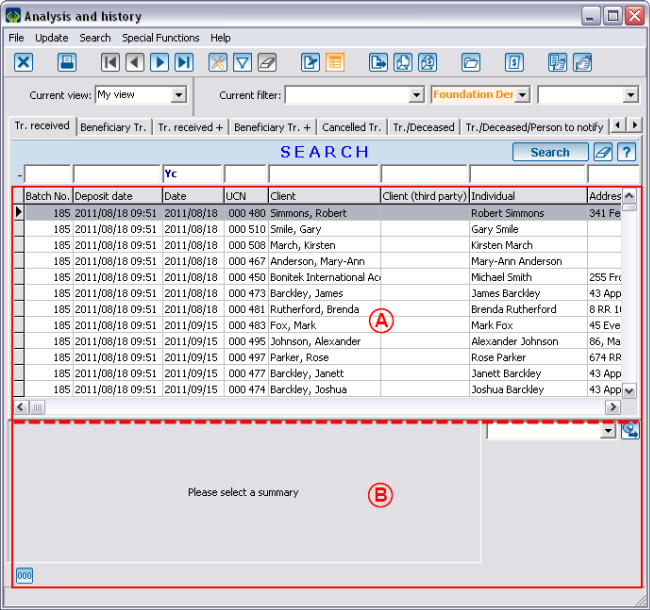
|
|
A: The top part contains the active list.
|
B: The bottom part allows you to select the analysis summary.
|
|
The section intended for the summary presents three elements.
|
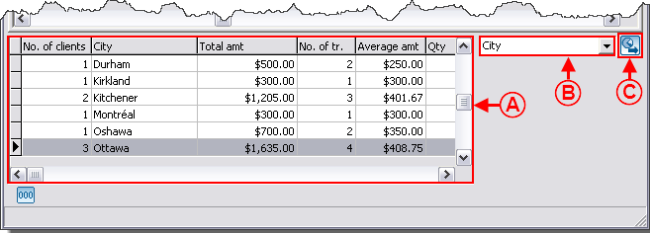
|
|
A: It is the result of the summary.
|
B: This drop-down list allows you to choose the type of summary that will be displayed in A.
|
|
C: This button allows you to export data to Excel.
|
|
|
Certain summaries require additional information.
|
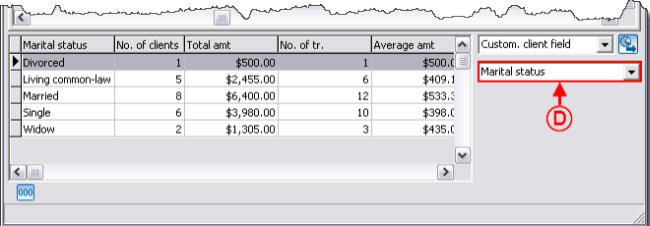
|
|
D: This option depends on the type of summary selected in B. For instance, to use the "Custom. client field", which means "Customized client field", you must choose the name of the field on which the summary will be made. In this example, the "Marital status" field has been selected.
|
NOTE: There are several types of options: for characteristics and customized fields summaries, you have to choose the field or the characteristic proper to the summary to produce. For a donation occasion summary, there is an option to check. For a date summary, there are two options to select: the period of the summary (year, month or day) and if the summary is based onthe transaction date or on the deposit date. For all the other types of summary, there is no additional option to select.
|
Exporting Summaries to Excel
It is possible to export data from the summary using the  button.
button.
"Summaries" Tab
|
After clicking on the  button, this window opens in order to configure the exportation to Excel. button, this window opens in order to configure the exportation to Excel.
|
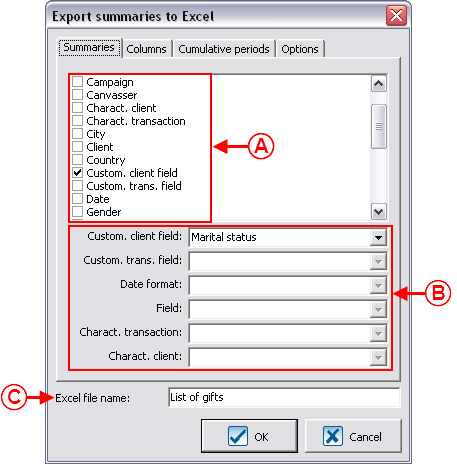
|
|
A: First indicate which summaries should be exported to Excel. By default, the summary previously chosen is already checked. However, it is possible to export many summaries at the same time.
|
B: This section allows you to specify the complementary information to bring to the characteristics, customized fields or date summaries. By default, if none of the summaries requiring a specification has been checked, all the fields will be greyed out. As soon as a field requiring a specification is checked in A, the lines necessary to the specification will be released.
|
|
C: To export to Excel, the database creates a file in the computer. It is therefore possible to choose the name.
|
|
"Columns" Tab
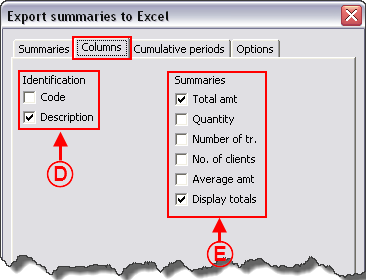
|
|
D: The "Identification" section allows you to indicate the type of summary and its code.
Here are two examples:
- For a summary by city, the description is the name of the city and there is no code.
- For a summary by donation occasion, the description is the name of the donation occasion and the code is the same as the donation occasion's.
|
E: The "Summaries" section allows you to indicate which amounts will be trasferred to Excel.
|
|
NOTE: These options are the same for all the types of summaries, except for the following four: "Client", "Third-party client", "linked to (1)" and "linked to (2)". In these four cases, the fields relating to clients are added under "Identification".
|
"Cumulative periods" Tab
"Options" Tab
Excel Functions on Summaries
Document name: ProDon:Analysis Summary
![]() button to display the summaries.
button to display the summaries.
![]() button.
button.


